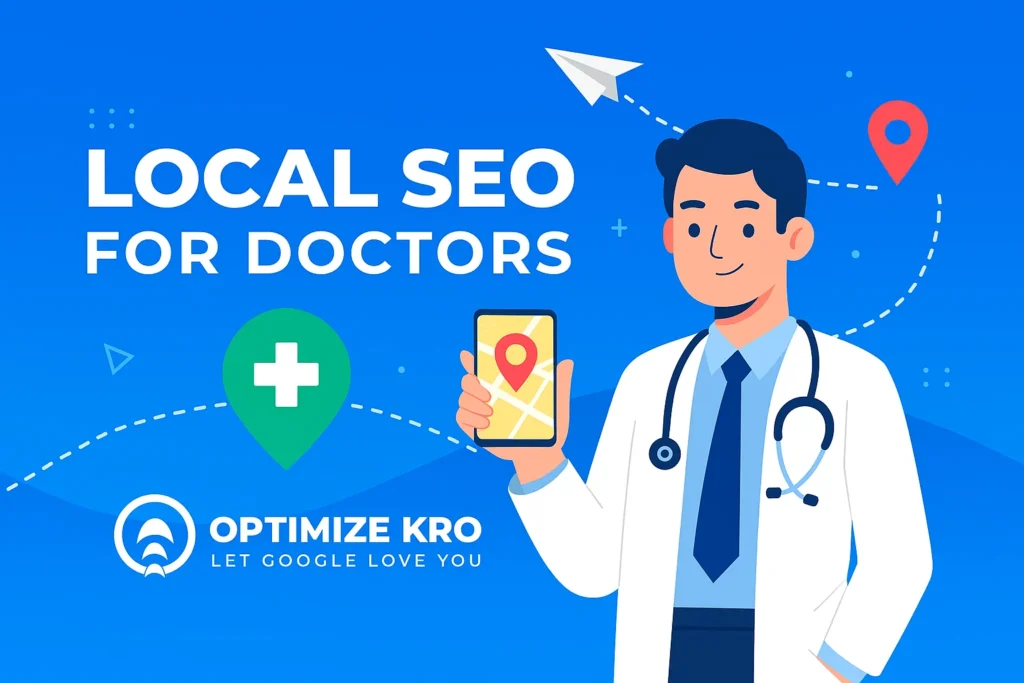In today’s digital age, having a strong online presence is essential for businesses of all types, including healthcare professionals. Local SEO (Search Engine Optimization) is crucial for doctors who want to ensure their practice is visible in local search results. When potential patients search for medical services near them, they typically choose the first results that appear on Google. Without proper optimization, your practice could be invisible to the patients who need your services the most.
- What is Local SEO for Doctors?
- Why Local SEO Matters for Doctors
- Key Factors in Local SEO for Doctors
- What Our Clients Say
- Cost and Timeline for Local SEO for Doctors
- Conclusion
- Frequently Asked Questions (FAQs)
- 1. How long does it take to see results from local SEO for doctors?
- 2. Is Google My Business essential for local SEO?
- 3. What are local citations, and why are they important?
- 4. Can I do local SEO for my practice myself?
- 5. How can patient reviews impact my local SEO?
- 6. What are the best tools for local SEO for doctors?

In this comprehensive guide, we will cover everything you need to know about local SEO for doctors. From cost and timeline to the tools, strategies, and techniques that will help you rank higher in local searches. We will also explore the importance of Google My Business (GMB), on-page SEO, off-page SEO, technical SEO, local citations, and more.
What is Local SEO for Doctors?
Local SEO is the process of optimizing your online presence to appear in search results for location-based queries. For doctors, this means ensuring that your practice is visible to potential patients when they search for healthcare services in your area. This type of SEO is focused on targeting the local audience—people who live in your city, county, or region—and is especially important for service-based businesses like medical practices.
When someone searches for a service like “dentist near me” or “best family doctor in [city name],” search engines use local signals, such as the user’s location and local business information, to rank and display relevant results. By optimizing your practice’s website, Google My Business profile, and other online factors, you increase your chances of appearing in those local searches.
Why Local SEO Matters for Doctors
Local SEO is vital for doctors for several reasons:
- Increased Visibility: Ranking higher on search engines increases your visibility and drives more traffic to your website.
- Trust and Credibility: Appearing in local search results gives potential patients the confidence that your practice is reputable and trusted by the local community.
- Targeted Traffic: Local SEO helps attract patients who are specifically searching for services in their area, improving the quality of leads and increasing the likelihood of conversions.
- Competing with Local Practices: Medical practices face fierce competition in local search results. Proper SEO ensures you stand out among other providers offering similar services.
- Mobile Optimization: A significant portion of local searches is conducted via mobile devices. Local SEO ensures your practice shows up in mobile search results, reaching patients when they’re on-the-go.
Key Factors in Local SEO for Doctors
When optimizing your medical practice’s website and online presence for local search, there are several key factors to consider:
1. Google My Business (GMB)
Google My Business (GMB) is a free tool provided by Google that allows you to manage your online presence across Google Search and Google Maps. GMB is critical for local SEO, as it helps your practice appear in the local “3-Pack” — the three businesses that appear at the top of the local search results.
Steps to Optimize Your GMB Profile:
- Complete your profile: Ensure that all details, such as your practice name, address, phone number, website URL, hours of operation, and specialty, are accurate and up-to-date.
- Add high-quality images: Upload professional photos of your practice, staff, and facilities to make your profile stand out.
- Collect patient reviews: Encourage patients to leave positive reviews on your GMB profile. Google considers reviews an important factor when ranking local businesses.
- Use posts and updates: Keep your GMB profile fresh by posting updates, announcements, and special offers regularly.
2. On-Page SEO
On-page SEO involves optimizing individual pages on your website to make them more search-engine-friendly. The goal is to provide search engines with relevant, valuable content and improve user experience.
Key On-Page SEO Factors:
- Keywords: Research local keywords (such as “dentist in [city name]” or “best pediatrician near me”) and incorporate them naturally into your website’s content, titles, and meta descriptions.
- Title Tags and Meta Descriptions: Write compelling title tags and meta descriptions that include local keywords to improve click-through rates from search results.
- Content Optimization: Create high-quality, informative content that answers common patient questions and solves problems. Incorporate local keywords and phrases throughout the content.
- Internal Linking: Use internal links to guide users through your site and help search engines understand the structure of your website.
- Mobile Optimization: Since many local searches come from mobile devices, ensure your website is mobile-friendly, fast, and easy to navigate.
3. Off-Page SEO
Off-page SEO refers to external factors that influence your website’s ranking, such as backlinks, social media mentions, and online reviews.
Key Off-Page SEO Strategies for Doctors:
- Building Backlinks: Obtain high-quality backlinks from trusted websites (such as local news sites or authoritative medical blogs) to improve your domain authority.
- Local Citations: Citations are mentions of your practice’s name, address, and phone number (NAP) on other websites, such as local directories, medical associations, and review sites. Ensure consistency across all listings.
- Social Media Engagement: Create and maintain active social media profiles on platforms like Facebook, Instagram, and LinkedIn. Engage with your community and encourage patients to leave reviews.
4. Technical SEO
Technical SEO involves optimizing the technical aspects of your website to improve search engine crawling and indexing. While technical SEO may require a more advanced understanding, it is essential for improving your website’s performance.
Key Technical SEO Elements:
- Website Speed: Ensure your website loads quickly, as site speed is a ranking factor for search engines and a critical element for user experience.
- SSL Certificate: Secure your website with HTTPS encryption to protect patient data and improve trust signals.
- XML Sitemap: Ensure your website has a sitemap to help search engines crawl and index your pages effectively.
- Structured Data Markup: Implement schema markup (structured data) to help search engines understand your content better and display rich snippets in search results.
5. Local Citations
Local citations are any online mention of your practice’s NAP (Name, Address, Phone number) information. These citations help search engines verify the legitimacy and consistency of your business. The more citations your practice has, the better it will perform in local search rankings.
Where to Build Local Citations:
- Local directories: Websites like Yelp, Yellow Pages, and local Chamber of Commerce sites.
- Healthcare-specific directories: Websites like Healthgrades, Vitals, and WebMD.
- Local news and media outlets: Partnering with local media outlets or being featured in local news stories can also improve your practice’s online visibility.
6. Patient Reviews and Reputation Management
Patient reviews play a vital role in local SEO for doctors. Positive reviews not only build your practice’s reputation but also impact your rankings in local search results.
How to Manage Patient Reviews:
- Encourage reviews: After appointments, ask satisfied patients to leave reviews on platforms like Google My Business, Healthgrades, or Facebook.
- Respond to reviews: Respond to both positive and negative reviews professionally and empathetically. This shows that you value patient feedback and are committed to improving your services.
- Monitor your online reputation: Use tools like Reputation.com or Podium to monitor your reviews across different platforms and address any negative comments promptly.
7. Content Marketing and Blogging
A strong content marketing strategy can enhance your local SEO efforts. Regularly publishing blog posts about topics relevant to your patients can help establish your authority in your niche while driving organic traffic to your website.
Blog Ideas for Doctors:
- “What to Expect During Your First Visit to a Pediatrician”
- “Top 5 Tips for Preventing Seasonal Allergies in [City Name]”
- “How to Choose the Right Dentist for Your Family”
Ensure that your blog posts are optimized with local keywords and provide valuable, informative content that resonates with your target audience.
What Our Clients Say
Trusted by contractors and local businesses for proven Local SEO Services.
John M. – General Contractor
“These guys transformed my Google Maps ranking. More calls, more local leads, and better visibility!”
Sarah L. – Roofing Business
“Within 3 months, my business went from page 3 to the top 3 listings. Highly recommend their Local SEO service!”
David K. – Plumbing Services
“Affordable and effective SEO. My local service calls doubled in less than 90 days.”
Cost and Timeline for Local SEO for Doctors
Cost of Local SEO for Doctors
The cost of local SEO for doctors can vary depending on several factors, including the scope of work, competition in your area, and whether you handle SEO in-house or hire a professional agency.
- DIY Local SEO: If you handle SEO in-house, the costs will mainly involve tools (like keyword research tools, SEO plugins, and website hosting) and time. The cost could range from a few hundred to a few thousand dollars per year.
- Hiring an Agency: A professional SEO agency typically charges between $1,000 to $5,000 per month for local SEO services. This price can vary based on the level of competition and the size of your practice.
Timeline for Results
SEO is a long-term strategy, and results won’t happen overnight. Generally, it takes around 3 to 6 months to see noticeable improvements in your local rankings. However, the timeline can vary depending on the competitiveness of your niche and the effectiveness of your SEO efforts.
Conclusion
Local SEO for doctors is an essential component of digital marketing that can significantly impact the success of your medical practice. By optimizing your Google My Business profile, focusing on on-page and off-page SEO, building local citations, and encouraging patient reviews, you can improve your online visibility and attract more patients. While the process requires time and effort, the long-term benefits make it a worthwhile investment for any doctor looking to grow their practice in a competitive market.
Frequently Asked Questions (FAQs)
1. How long does it take to see results from local SEO for doctors?
It generally takes 3 to 6 months to see significant improvements in local SEO rankings, but this depends on the competitiveness of your area and the SEO strategies you implement.
2. Is Google My Business essential for local SEO?
Yes, Google My Business is one of the most important factors for local SEO. It helps your practice appear in local search results and Google Maps, increasing visibility to potential patients.
3. What are local citations, and why are they important?
Local citations are mentions of your practice’s NAP (Name, Address, Phone number) on other websites, such as local directories. Consistent citations across multiple trusted sites improve your local search rankings.
4. Can I do local SEO for my practice myself?
Yes, with the right tools and knowledge, you can implement local SEO yourself. However, if you’re short on time or want to ensure the best results, hiring an experienced SEO professional or agency may be a good investment.
5. How can patient reviews impact my local SEO?
Positive patient reviews are a critical ranking factor for local SEO. They help build trust with both Google and potential patients. Regularly encouraging reviews and responding to them can boost your practice’s visibility in search results.
6. What are the best tools for local SEO for doctors?
Some of the best tools for local SEO include:
- Google My Business: For managing your practice’s profile and local visibility.
- Moz Local: For managing local citations and listings.
- SEMrush or Ahrefs: For keyword research and backlink analysis.
- Yoast SEO: For optimizing on-page content if you use WordPress.
By following these strategies and using the right tools, you can significantly improve your local SEO and grow your medical practice online.

Gulfam Qamar is a seasoned Local SEO expert with a proven track record of helping businesses boost their online visibility and dominate local search results. With deep expertise in Google Business Profiles, on-page optimization, and local citation strategies, Gulfam helps brands connect with nearby customers and grow sustainably. When he’s not optimizing websites, he’s sharing actionable SEO tips and insights to empower small businesses in the digital space.

